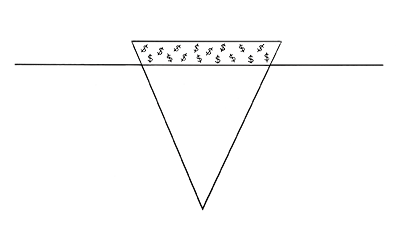Business Model Generation: Customer segment
Bottom of the Pyramid
Sell affordable products with low profit margins in high numbers

How: Tailor products and services towards bottom-of-the-pyramid markets.
Why: Earn less per product but sell to a very large customer base.
Serving the Underprivileged. Bottom of the Pyramid is a business model that aims to provide affordable products and services to individuals living in low-income countries. These individuals, who typically earn less than $2,000 per year (adjusted for purchasing power), constitute over half of the world’s population and present a significant market opportunity despite their limited financial resources.
To reach this customer group, it is often necessary to modify traditional business models and streamline products, as well as to devise new distribution and logistics strategies that take into account the rudimentary infrastructure often present in emerging economies and lower-income countries.
Where did the Bottom of the Pyramid business model pattern originate from?
The Bottom of the Pyramid model, or “Target the Poor” as it is also called, emerged in the 1990s as a response to strong economic growth in countries such as China, India, and Latin America, which led to increased demand in these markets. One notable example of this approach is Unilever’s Indian subsidiary, Hindustan Unilever, which developed and introduced Wheel, a laundry detergent specifically tailored to the needs of the Indian market. By decentralizing production, marketing, and distribution and selling the product through local corner shops and Shakti entrepreneurs who went door-to-door, Hindustan Unilever was able to increase its revenues by 25% and market capitalization by 40% between 1995 and 2000. Today, Wheel is one of the top-selling laundry detergents in India.
Applying the Bottom of the Pyramid business model
The Bottom of the Pyramid business model seeks to address the needs of lower-income customers, who constitute a large and untapped market with significant potential for sustainable business development. By offering products and services that address pressing needs such as affordable healthcare or clean drinking water, companies can not only benefit from positive public relations, but also create value for their employees.
It is worth noting that this demographic is increasingly connected, with an increasing number of individuals in lower-income economies accessing the internet through mobile devices. These customers may be among the first to browse the web, even if they do not yet have access to basic necessities like running water or reliable electricity.
Real life Bottom of the Pyramid examples
Fan Milk
The West African frozen dairy and juice company pioneered bicycle vendor distribution and provides free vendor bike repairs.
SC Johnson
Insect-control products were sold in rural Ghana through hands-on demonstrations, product-bundling, and refillable boxes.
Grameen Bank
Founded in 1983 by Muhammad Yunus, Grameen Bank is a microfinance institution that provides impoverished individuals without adequate collateral with small, easily repayable loans, instilling discipline and building strong credit standing in the process. Nearly 98% of borrowers supported by the bank are rural women, and the village community often acts as a guarantor for loans, adding social pressure to meet repayments. With a default rate of less than 2%, Grameen Bank has issued over $8 billion in loans since its founding.
Tata Nano
Developed by Indian car manufacturer Tata in 2009, the Tata Nano is a practical and cost-effective vehicle that retails for just $2,500. The car is manufactured using a low-cost Indian labor force and streamlined processes that minimize the use of steel, and benefits from international engineering contributions and outsourcing. By addressing the needs of impoverished individuals and promoting accessibility, Tata has gained a positive public image.
Wal-Mart
In response to the global financial crisis, retail giant Wal-Mart introduced Bottom of the Pyramid model banking services in the United States, offering financial products and services tailored to low-income customers, including prepaid credit cards. As the company does not hold a banking license, it is limited to offering financial services that do not require accreditation.
Trigger Questions
- How can you make existing services attractive to customers who can’t afford them at this moment?
- How can you bundle your products to be more accessible and understood by lower income customers?
- What other services or products might we be able to offer to lower-income customers in addition to our current clientele?
- Is it possible to expand our customer base by adapting our solutions for use on mobile devices?
Proven business models that have driven success for global leaders across industries. Rethink how your business can create, deliver, and capture value.
Get your deck!Related plays
- Business Model Navigator by Karolin Frankenberger and Oliver Gassmann
- Profits at the Bottom of the Pyramid by Harvard Business Review
- Reality Check at the Bottom of the Pyramid by Harvard Business Review
